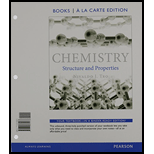
Interpretation:
To find ∆H for the reaction with the equilibrium constant 0.65 at 755 K.
Concept introduction:
► The equilibrium constant is defined as a ratio of the concentration of the products to the concentration of the reactants. If the K value is less than one the reaction will move to the left and if the K value is greater than one the reaction will move to the right.
► Enthalpy change is the name given to the amount of heat evolved or absorbed in a reaction carried out at constant pressure. It is given the symbol ΔH, read as "∆H". The term "enthalpy change" only applies to reactions done at constant pressure.
To determine:
Want to see the full answer?
Check out a sample textbook solution
Chapter 19 Solutions
Chemistry: Structure and Properties, Books a la Carte Edition & Modified MasteringChemistry with Pearson eText -- ValuePack Access Card -- for Chemistry: Structure and Properties Package
- Use the data in Appendix J to calculate rG andKPat 25 C for the reaction 2HBr(g)+Cl2(g)2HCl(g)+Br2() Comment on the connection between the sign of rG and the magnitude ofKP.arrow_forwardHydrogen gas and iodine gas react to form hydrogen iodide. If 0.500 mol H2 and 1.00 mol I2 are placed in a closed 10.0-L vessel, what is the mole fraction of HI in the mixture when equilibrium is reached at 205C? Use data from Appendix C and any reasonable approximations to obtain K.arrow_forwardConsider the reaction CO(g)+H2O(g)CO2(g)+H2(g) Use the appropriate tables to calculate (a) G at 552C (b) K at 552Carrow_forward
- For each reaction, an equilibrium constant at 298 K is given. Calculate G for each reaction. (a) H+(aq) + OH-(aq)H2O Kc = 1.0 1014 (b) CaSO4(s)Ca2+(aq) + SO42 (aq) Kc = 7.1 105 (c) HIO3(aq)H+(aq) + IO3 (aq) Kc = 1.7 101arrow_forwardUse data given in Tables 6.2 and 18.1 to obtain the value of Kp at 1000C for the reaction C(graphite)+CO2(g)2CO(g) Carbon monoxide is known to form during combustion of carbon at high temperatures. Do the data agree with this? Explain.arrow_forwardGiven the following data at 25C 2NO(g)N2(g)+O2(g)K=1 10 30 2NO(g)+Br2(g)2NOBr(g)K=8 101 Calculate K for the formation of one mole of NOBr from its elements in the gaseous state.arrow_forward
- Predict whether each of the following processes results in an increase in entropy in the system. (Define reactants and products as the system.) (a) Water vapor condenses to liquid water at 90 C and 1 atm pressure. (b) The exothermic reaction of Na(s) and Cl2(g) forms NaCl(s). (c) The endothermic reaction of H2 and I2 produces an equilibrium mixture of H2(g), I2(g), and HI(g). (d) Solid NaCl dissolves in water forming a saturated solution.arrow_forwardHydrogenation, the addition of hydrogen to an organic compound, is an industrially important reaction. Calculate rH, rS, and rG for the hydrogenation of octene, C8H16, to give octane, C8H19 at 25 C. Is the reaction product- or reactant-favored at equilibrium? C8H16(g) + H2(g) C8H18(g) Along with data in Appendix L, the following information is needed for this calculation.arrow_forwardExplain how the entropy of the universe increases when an aluminum metal can is made from aluminum ore. Thefirst step is to extract the ore, which is primarily a formof A12O3, from the ground. After it is purified by freeingit from oxides of silicon and iron, aluminum oxide ischanged to the metal by an input of electrical energy. 2Al2O3(s)electricalenergy4Al(s)+3O2(g)arrow_forward
- Consider the following hypothetical reactions and their equilibrium constants at 75C, 3A(g)3B(g)+2C(g)K1=0.31 3D(g)+2B(g)2C(g)K1=2.8 Find the equilibrium constant at 75C for the following reaction A(g)D(g)+53B(g)arrow_forwardDistinguish between the terms equilibrium constant and reaction quotient. When Q = K, what does this say about a reaction? When Q K, what does this say about a reaction? When Q K. what does this say about a reaction?arrow_forwardThe standard free energy change, rG, for the formation of NO(g) from its elements is + 86.58 kJ/mol-rxn at 25 C. Calculate Kp at this temperature for the equilibrium N2(g) + O2(g) NO(g) Comment on the sign of rG and the magnitude of Kp.arrow_forward
 Chemistry: Principles and ReactionsChemistryISBN:9781305079373Author:William L. Masterton, Cecile N. HurleyPublisher:Cengage Learning
Chemistry: Principles and ReactionsChemistryISBN:9781305079373Author:William L. Masterton, Cecile N. HurleyPublisher:Cengage Learning
 Chemistry: An Atoms First ApproachChemistryISBN:9781305079243Author:Steven S. Zumdahl, Susan A. ZumdahlPublisher:Cengage Learning
Chemistry: An Atoms First ApproachChemistryISBN:9781305079243Author:Steven S. Zumdahl, Susan A. ZumdahlPublisher:Cengage Learning ChemistryChemistryISBN:9781305957404Author:Steven S. Zumdahl, Susan A. Zumdahl, Donald J. DeCostePublisher:Cengage Learning
ChemistryChemistryISBN:9781305957404Author:Steven S. Zumdahl, Susan A. Zumdahl, Donald J. DeCostePublisher:Cengage Learning Principles of Modern ChemistryChemistryISBN:9781305079113Author:David W. Oxtoby, H. Pat Gillis, Laurie J. ButlerPublisher:Cengage Learning
Principles of Modern ChemistryChemistryISBN:9781305079113Author:David W. Oxtoby, H. Pat Gillis, Laurie J. ButlerPublisher:Cengage Learning Chemistry: Principles and PracticeChemistryISBN:9780534420123Author:Daniel L. Reger, Scott R. Goode, David W. Ball, Edward MercerPublisher:Cengage Learning
Chemistry: Principles and PracticeChemistryISBN:9780534420123Author:Daniel L. Reger, Scott R. Goode, David W. Ball, Edward MercerPublisher:Cengage Learning





